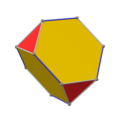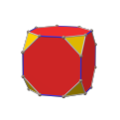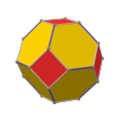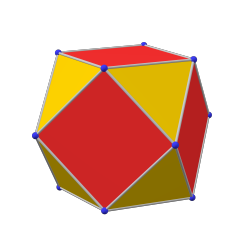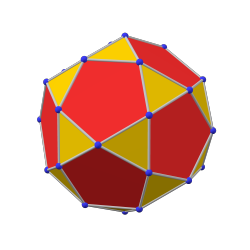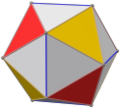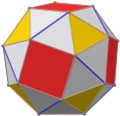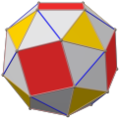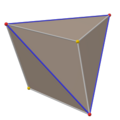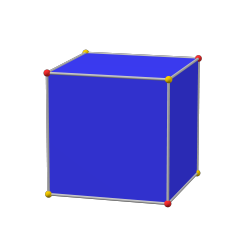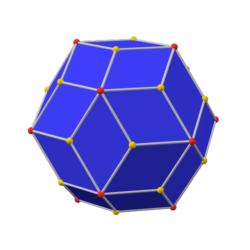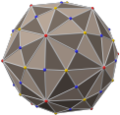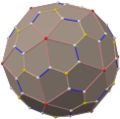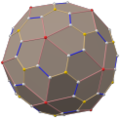Construction
The truncated dodecahedron is constructed from a regular dodecahedron by cutting all of its vertices off, a process known as truncation. [1] Alternatively, the truncated dodecahedron can be constructed by expansion: pushing away the edges of a regular dodecahedron, forming the pentagonal faces into decagonal faces, as well as the vertices into triangles. [2] Therefore, it has 32 faces, 90 edges, and 60 vertices. [3]
The truncated dodecahedron may also be constructed by using Cartesian coordinates. With an edge length  centered at the origin, they are all even permutations of
centered at the origin, they are all even permutations of  where
where  is the golden ratio. [4]
is the golden ratio. [4]
Properties
The surface area  and the volume
and the volume  of a truncated dodecahedron of edge length
of a truncated dodecahedron of edge length  are: [3]
are: [3] 
The dihedral angle of a truncated dodecahedron between two regular dodecahedral faces is 116.57°, and that between triangle-to-dodecahedron is 142.62°. [5]
The truncated dodecahedron is an Archimedean solid, meaning it is a highly symmetric and semi-regular polyhedron, and two or more different regular polygonal faces meet in a vertex. [6] It has the same symmetry as the regular icosahedron, the icosahedral symmetry. [7] The polygonal faces that meet for every vertex are one equilateral triangle and two regular decagon, and the vertex figure of a truncated dodecahedron is  . The dual of a truncated dodecahedron is triakis icosahedron, a Catalan solid, [8] which shares the same symmetry as the truncated dodecahedron. [9]
. The dual of a truncated dodecahedron is triakis icosahedron, a Catalan solid, [8] which shares the same symmetry as the truncated dodecahedron. [9]
The truncated dodecahedron is non-chiral, meaning it is congruent to its mirror image. [7]
This page is based on this
Wikipedia article Text is available under the
CC BY-SA 4.0 license; additional terms may apply.
Images, videos and audio are available under their respective licenses.














